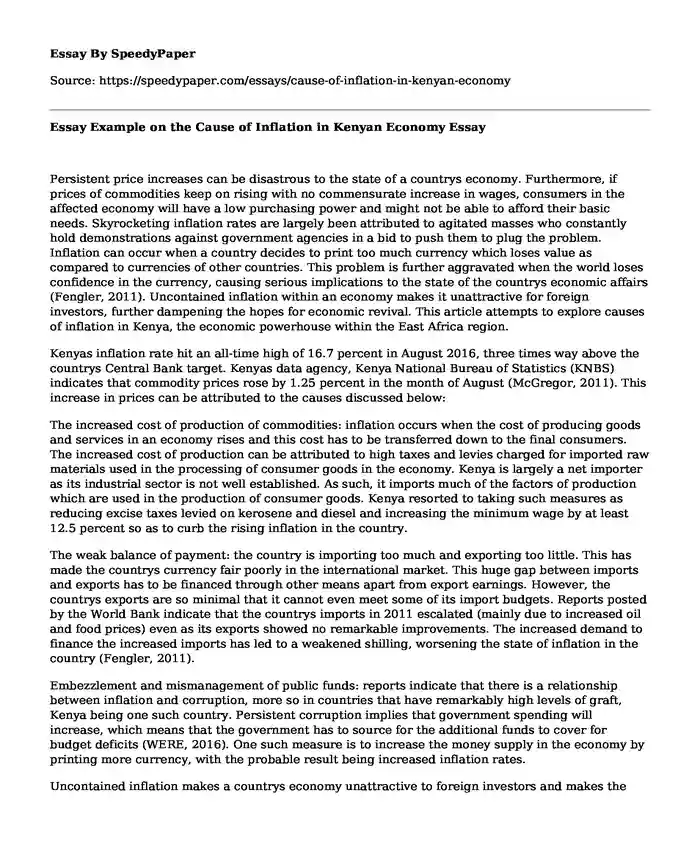Persistent price increases can be disastrous to the state of a countrys economy. Furthermore, if prices of commodities keep on rising with no commensurate increase in wages, consumers in the affected economy will have a low purchasing power and might not be able to afford their basic needs. Skyrocketing inflation rates are largely been attributed to agitated masses who constantly hold demonstrations against government agencies in a bid to push them to plug the problem. Inflation can occur when a country decides to print too much currency which loses value as compared to currencies of other countries. This problem is further aggravated when the world loses confidence in the currency, causing serious implications to the state of the countrys economic affairs (Fengler, 2011). Uncontained inflation within an economy makes it unattractive for foreign investors, further dampening the hopes for economic revival. This article attempts to explore causes of inflation in Kenya, the economic powerhouse within the East Africa region.
Kenyas inflation rate hit an all-time high of 16.7 percent in August 2016, three times way above the countrys Central Bank target. Kenyas data agency, Kenya National Bureau of Statistics (KNBS) indicates that commodity prices rose by 1.25 percent in the month of August (McGregor, 2011). This increase in prices can be attributed to the causes discussed below:
The increased cost of production of commodities: inflation occurs when the cost of producing goods and services in an economy rises and this cost has to be transferred down to the final consumers. The increased cost of production can be attributed to high taxes and levies charged for imported raw materials used in the processing of consumer goods in the economy. Kenya is largely a net importer as its industrial sector is not well established. As such, it imports much of the factors of production which are used in the production of consumer goods. Kenya resorted to taking such measures as reducing excise taxes levied on kerosene and diesel and increasing the minimum wage by at least 12.5 percent so as to curb the rising inflation in the country.
The weak balance of payment: the country is importing too much and exporting too little. This has made the countrys currency fair poorly in the international market. This huge gap between imports and exports has to be financed through other means apart from export earnings. However, the countrys exports are so minimal that it cannot even meet some of its import budgets. Reports posted by the World Bank indicate that the countrys imports in 2011 escalated (mainly due to increased oil and food prices) even as its exports showed no remarkable improvements. The increased demand to finance the increased imports has led to a weakened shilling, worsening the state of inflation in the country (Fengler, 2011).
Embezzlement and mismanagement of public funds: reports indicate that there is a relationship between inflation and corruption, more so in countries that have remarkably high levels of graft, Kenya being one such country. Persistent corruption implies that government spending will increase, which means that the government has to source for the additional funds to cover for budget deficits (WERE, 2016). One such measure is to increase the money supply in the economy by printing more currency, with the probable result being increased inflation rates.
Uncontained inflation makes a countrys economy unattractive to foreign investors and makes the purchasing power of consumers weaker. Kenya needs to take appropriate measures such as cutting down misuse of public funds and filling the wide balance of payment gap so as to contain the high levels of inflation.
References
Fengler, W. (2011). Why has the Kenyan Shilling declined so sharply?. AfricaCan End Poverty. Retrieved 9 September 2016, from http://blogs.worldbank.org/africacan/why-has-the-kenyan-shilling-declined-so-sharply
McGregor, S. (2011). Kenyan Inflation Surges to 16.7% on Shilling Slump, Drought - Bloomberg. Bloomberg.com. Retrieved 9 September 2016, from http://www.bloomberg.com/news/articles/2011-08-30/kenya-s-inflation-accelerates-to-16-7-adding-pressure-on-central-bank
WERE, A. (2016). How rampant graft increases inflation rate. Businessdailyafrica.com. Retrieved 9 September 2016, from http://www.businessdailyafrica.com/Opinion-and-Analysis/How-graft-increases-inflation-rate/539548-2712734-okchek/index.html
Cite this page
Essay Example on the Cause of Inflation in Kenyan Economy. (2019, Oct 29). Retrieved from https://speedypaper.com/essays/cause-of-inflation-in-kenyan-economy
Request Removal
If you are the original author of this essay and no longer wish to have it published on the SpeedyPaper website, please click below to request its removal:
- Out of the Transylvania Night - Book Analysis in the Free Essay
- Free Essay: Business Plan Sample
- Education Essay Sample: Coddling the American Mind
- Business Essay Sample: External Environment Analysis
- The Relationship Between Memory and Culture, Free Essay
- Amazon's Strategic Positioning in the E-Commerce Segment, Marketing Essay Example
- Essay Sample on Why English Should Be the Language of Business
Popular categories





